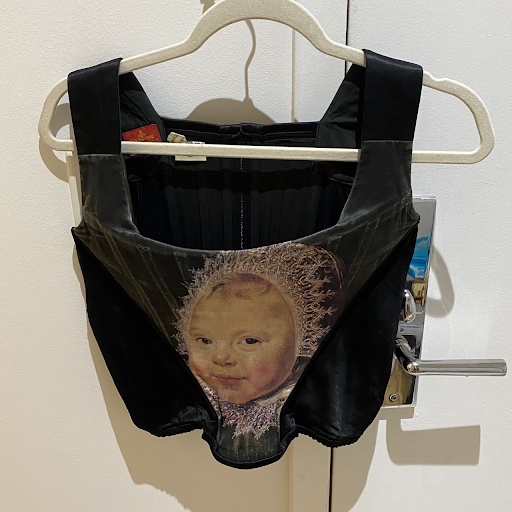Divided Bodies: the Art & Controversy of the Corset
While re-watching all the Pirates of the Caribbean films over lockdown, my 21-year-old bisexual self had a long overdue realisation: this movie series had been my sexual awakening. Although I didn’t clock it at the time, my younger self hadn’t wanted to be Keira Knightley aka Elizabeth Swan – she’d wanted to rescue her from the ocean, to rip off her too-tight corset and bring her back to breath with some well-shot mouth-to-mouth resuscitation.
Vivienne Westwood A/W 1992 via trustfundgoth on Depop
It seems obvious now how Pirates of the Caribbean was a formative influence on my sexuality: the sexy androgyny of pirate-wear; all the girls have swords and all the guys have long hair. Something about the grungy neo-renaissance costuming reminiscent of that Vivienne Westwood pirate collection has stuck with me powerfully, resulting in a nostalgic delight over the current trend for corsets, corset tops and all manner of corsetic derivations. From the aesthetic trailblazing of depop’s trustfundgoth to FKA Twigs and Bella Hadid, this style of renaissance punkature meets every main character fantasy. And what’s more, trends such as ‘bipiracy’ on tiktok have reinforced the notion of the corset with a strong bisexual energy, queered even more by the ways that the genderfluidity of pirate costume and punkature make you realise the broader potential of what masculinity and femininity can be.
But what is a corset, exactly? Historically, both male and female-bodied people have worn corsets of all different kinds.They were used aesthetically to support outer layers of clothing, to slim and shape the body, and also for medical purposes –– post-childbirth or to support spinal issues, for example. After he was shot. Andy Warhol wore a surgical corset until his death in 1987.
via FKA Twigs on Instagram
However, the history of corsetry also illuminates the garment’s problematic implications, many of which remain embodied in the style today and are important legacies to be conscious of. A significant example is the 19th century controversy concerning “tightlacing,” the practice of lacing someone into a corset so tightly that the shape of their body is significantly altered. The health consequences of tightlacing were extreme, including things such as damaged or rearranged internal organs and fertility problems, not to mention weakness and shortness of breath (vis a vis the famous fainting scene in Curse of the Black Pearl.) Oftentimes, mucus would accumulate in the bottom half of women’s lungs due to prolonged restriction by the corset they were wearing, or as Emily Berry writes with a cutting irony in her poem “a short guide to corseting”: now that I wear a 14-inch I use only the top half of my lungs.
Horrifically, tightlacing even extended to young girls, who were “corset trained” for their futures: At six she wore a corded corset with whalebones, and at thirteen her mother had her tightly laced, making her waist only fifteen inches*. This practice eventually led to an outrage of anti-corset sentiment in the infancy of the feminist awakening: Burn up the corsets! ... No, nor do you save the whalebones, you will never need whalebones again. Make a bonfire of the cruel steels that have lorded it over your thorax and abdomens for so many years and heave a sigh of relief, for your emancipation I assure you, from this moment has begun. But the “emancipation” which Elizabeth Stuart Phelps Ward writes of here is still yet to find fruition. The manipulation of womxn’s bodies to achieve a certain beauty standard and the subsequent body fascism required to enforce such notions still lingers maliciously in western culture today. If we followed the ‘hourglass figure’ fetishisation to its conclusion, then the ideal waist size would be having no waist at all, the laces drawn so tight that the body is cut in half, divided forever from itself. But after all, as Berry’s poem sardonically notes, for womxn, pain is the spine of life.
Frida Kahlo, The Broken Column (1944)
One of my favourite examples of corsets are Frida Kahlo’s intricately decorated ones. For Kahlo, disabled by a tragic accident at an early age, pain really was the spine of life. In her work, the corset occupies a space at the intersection of utility and aesthetic purpose, both a practical technology and an artistic resource. Her 1944 self-portrait The Broken Column depicts a body split in two by a crumbling column, representing her fractured spine, and pierced by crucifixion-esque nails. In contrast to a corset which cinches horizontally, Kahlo’s corset heals instead of divides the female body. The corset is radicalised by Kahlo as it is taken out of the sphere of body manipulation to achieve a certain aesthetic, and into a space of self-healing through art.
Similarly, Vivienne Westwood took the corset as a garment signifying oppression and subverted it from bespoke underwear to luxury outerwear. This marked the shifting ideas around female sexuality and the move towards the more liberated, genderfluid approach which allows for the maximum creative possibility. From Frida Kahlo’s representations of the queer, disabled body to Michaela Stark’s explorations of contour and corsetry via Instagram, it is clear that there is room for the corset still, just not in its traditional form. Through an experimental leaning into the ‘grotesque’ which flirts with the edges of acceptability, there is a new type of sensual somatic technology which seeks to celebrate rather than suppress the contours of the body. And at the end of the day, as Lisa Robertson puts it, the real beauty of corsetry lies in the ability to take it off:
Sometimes I want a corset like
to harden me or garnish. I
think of this stricture—rain
language, building—as a corset: an
outer ideal mould, I feel
the ideal moulding me the ideal
is now my surface just so very
perfect I know where to buy it and I
take it off. I take it off.
* NYT Archive.




